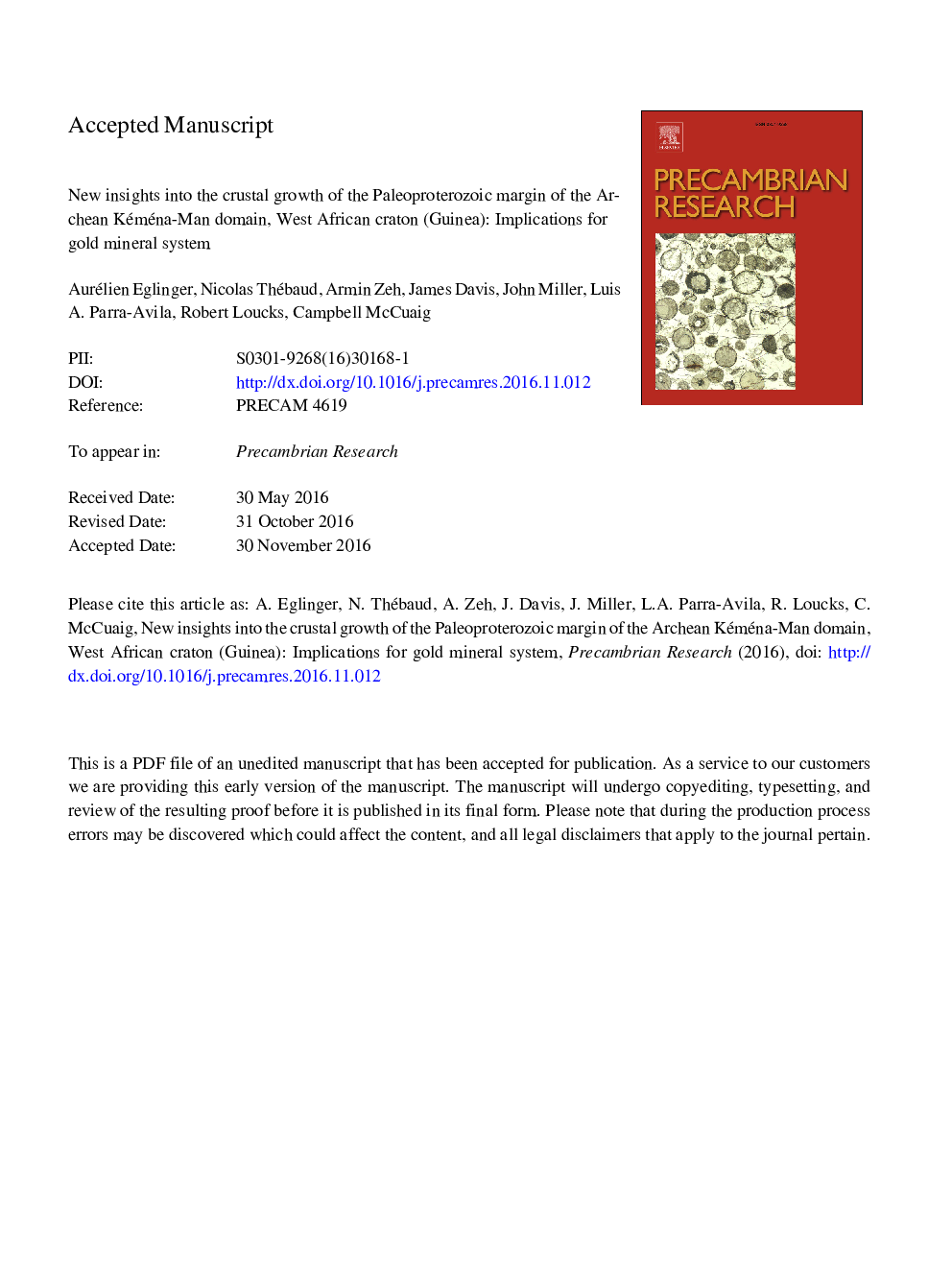| کد مقاله | کد نشریه | سال انتشار | مقاله انگلیسی | نسخه تمام متن |
|---|---|---|---|---|
| 5784767 | 1639583 | 2017 | 88 صفحه PDF | دانلود رایگان |
عنوان انگلیسی مقاله ISI
New insights into the crustal growth of the Paleoproterozoic margin of the Archean Kéména-Man domain, West African craton (Guinea): Implications for gold mineral system
دانلود مقاله + سفارش ترجمه
دانلود مقاله ISI انگلیسی
رایگان برای ایرانیان
موضوعات مرتبط
مهندسی و علوم پایه
علوم زمین و سیارات
ژئوشیمی و پترولوژی
پیش نمایش صفحه اول مقاله

چکیده انگلیسی
The Baoulé-Mossi Paleoproterozoic domain on the West African Craton is known for its world-class orogenic gold deposits formed during the Eburnean orogeny between ca. 2.15 and 2.07 Ga. New results of U-Pb zircon dating in combination with Hf-isotope geochemical data indicate that a suite of mafic and felsic potassic plutonites were emplaced in Guinea (in vicinity to the Archean Kéména-Man domain, KMD) between ca. 2.10 and 2.08 Ga. All plutonites are characterized by (i) enrichment in LILE and LREE, (ii) strong positive Pb spikes and (iii) depletion in Ta-Nb-Ti, but based on zircon U-Pb-Hf isotope data two groups can be distinguished, each comprising Qtz-monzodiorites and Bt-granites. Bt-granites of group 1, sampled away from the craton are xenocryst-free despite similar or higher Zr-saturation temperatures (â¼820 °C) compared to group 2 rocks (â¼780 °C), and reveal mostly superchondritic ÉHf(2.1 Ga) up to +3.7, (TDM = 2.8-2.4 Ga). Rocks of group 2, sampled in close vicinity to the KMD, show highly negative ÉHf(2.1 Ga) of â16 to â10 (TDM = 3.5-3.2 Ga) and contains abundant zircon xenocrysts with ages between 3.71 and 2.78 Ga (TDM = 4.2-3.4), overlapping with zircon U-Pb-Hf data obtained from three granodiorites of the KMD, dated at ca. 3.09, 3.08 and 2.87 Ga. This difference indicates that the potassic plutonites resulted from partial melting of different sources within the crust and mantle during the same magmatic event at ca. 2.10-2.08 Ga. The Qtz-monzodiorites derived from metasomatized mantle sources enriched by subducted sediments that in case of group 1 were derived from relatively juvenile Paleoproterozoic island arcs, and in case of group 2 from the Archean KMD. Bt-granites of group 1 might result either from reworking of relatively juvenile Paleoproterozoic crust, or from hybridization between (fractionated) monzodiorites and hot crustal melts, whereas Bt-granites of group 2 can be explained by in situ reworking of Archean TTG crust. Contemporaneous partial melting of the different mantle and crustal domains perhaps happened in response to lithospheric delamination following the collision of the juvenile Paleoproterozoic domain with the KMD. We further propose that this process also caused remelting of residual Au-rich cumulates left in the deep lithosphere by previous arc magmatism or Au-enriched metasomatic veins in lithospheric mantle.
ناشر
Database: Elsevier - ScienceDirect (ساینس دایرکت)
Journal: Precambrian Research - Volume 292, May 2017, Pages 258-289
Journal: Precambrian Research - Volume 292, May 2017, Pages 258-289
نویسندگان
Aurélien Eglinger, Nicolas Thébaud, Armin Zeh, James Davis, John Miller, Luis A. Parra-Avila, Robert Loucks, Campbell McCuaig, Elena Belousova,